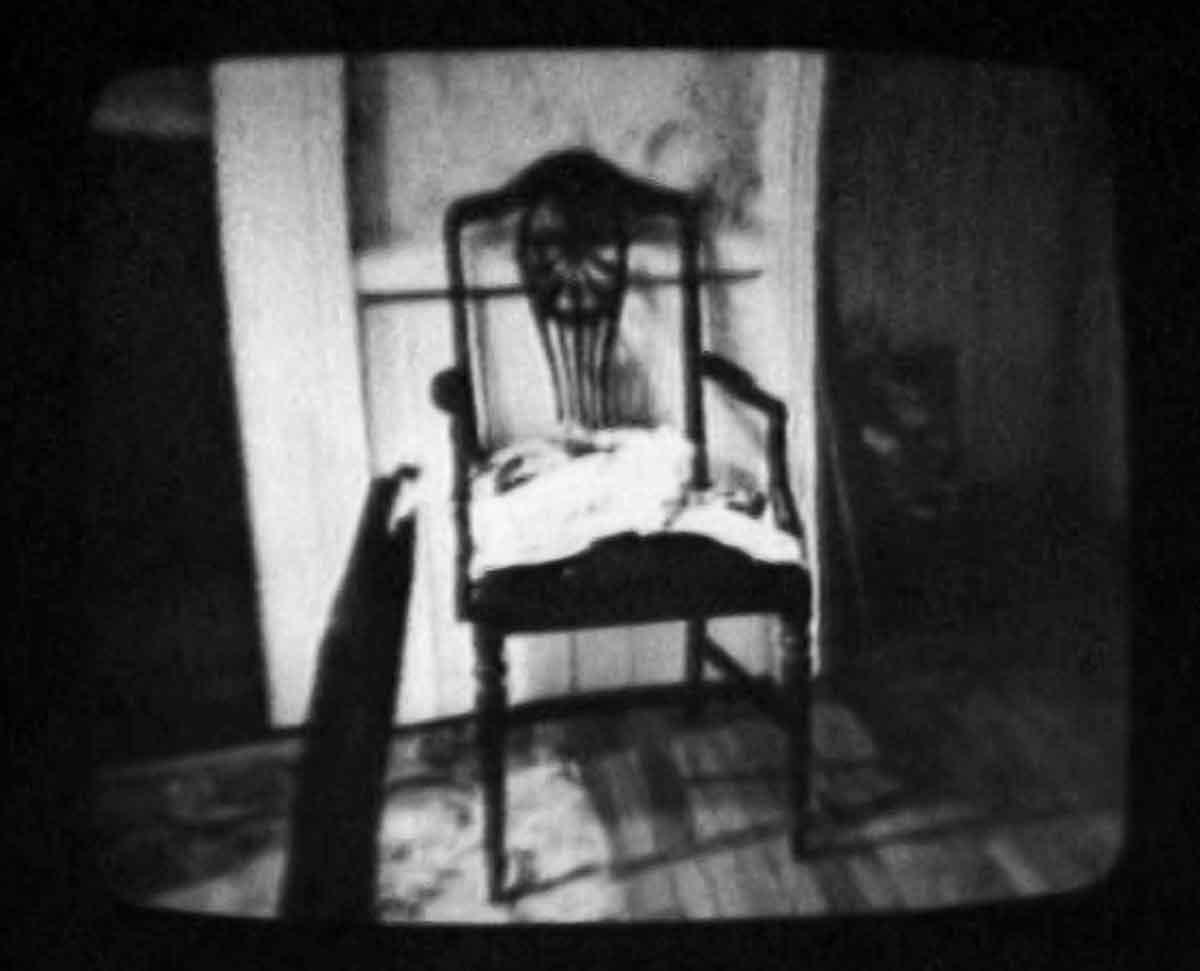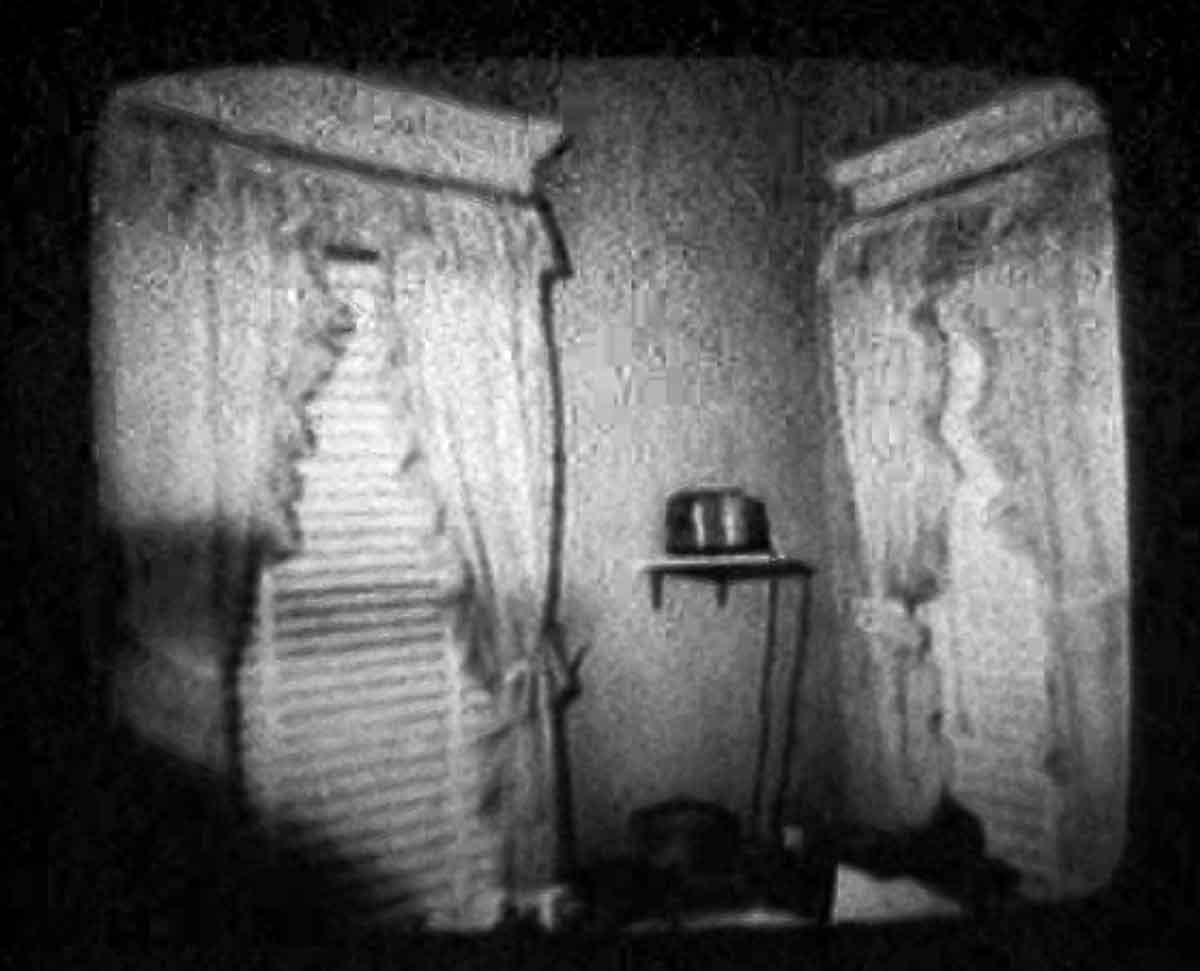Nancy Holt, "Underscan" (1974)
We locate ourselves in various ways: phenomenologically we understand our bodies within our surroundings, cartographically we measure our position on the earth, imaginatively we locate ourselves in relation to places we call home as much as those we have never visited. Much of Nancy Holt’s work pays close attention to these interlinked processes of locating. Holt’s 1974 video Underscan brings to the fore the act of imaginative location, and its ties to family and care. This act of locating had a lasting impact on her practice.
Holt described the complex tape concisely in a short text published in the Autumn 1974 issue of Art-Rite, an art world newspaper published in New York:
A series of photographs of my aunt’s home in New Bedford, Mass. have been videotaped, and re-videotaped from the underscaning monitor screen, which is framed within the final tape making a visual distance at 3 removes. Underscaning changes each static photo image, as it appears, from regular to elongated to compressed or visa versa. Excerpts from the letters of my Aunt spanning 10 years are condensed into 9 minutes of my voice-over audio. Certain yearly occurrences repeat, making an auditory rhythm, which coincides with the cycle of visual changes.1
The use of underscanning created a formal framework for the narrative element of the tape specific to the medium of video. This frame linked the work to the preoccupations with medium specificity, seriality, and the questioning of visuality which had reshaped contemporary art and art criticism in New York City across the previous decade.2 These formal references to advanced practice in the contemporaneous New York art world are kept in tension with the regionally focused narrative of the tape.3
The photographs taken by Holt show the interior and exterior of the large house at 39 Locust Street, New Bedford, Massachusetts occupied by her aunt, Ethel Holt-Tate. They were taken when the artist stayed in the house while her aunt was in hospital. The letters sent by Ethel Holt-Tate to her niece between 1962 and 1972, which are read by Holt in the voiceover, relate to the upkeep of the house (both economically and physically), and discuss her health and that of her two male lodgers. The home and the aging body combine in the narrative of the video, mixing several different temporal registers. The almost forensic photographs record the time of Holt’s visit. They document the house in a state of mild neglect while the sparse objects register continued occupation: a hanging wash lily, medicines on a cabinet, clothes on a chair. This mixture of dilapidation and everyday living is reflected in the letters that telescope the correspondence of a decade into nine minutes. Holt’s reading has a deadpan tone and the rhythm of a metronome flattening moments of high affective intensity: marriage and death are equivalent to the everyday experiences of planting roses or fixing the fence in this telling. The repetition of events includes seasonal activities—such as planting flowers, seeing them bloom—as well as less prosaic moments: two falls by Ethel in public that require a doctor’s attention, falls by both of her roomers Alex and Leo, with their eventual deaths mirroring one another in the reading.
The tempo of the tape, the way in which the underscanning constantly draws attention to the images as photographs, and the inexpressive framing of the images are all distancing devices. They push against the intimacy of the account given in the letters. Holt wrote “In video ‘distancing’ is one of my involvements,” she illustrated her Art Rite statement with a screenshot from Underscan captioned:
This is a newsprint photo
of a photograph
of a videotape
of an underscanned videotape
of a photograph
of a painting
of a photograph
of a garden.4
Holt’s chosen term of “distance” serves the ambiguity of the tape as it can be read in two quite different ways, on the one hand as the space between two points and on the other as emotional separation. Holt, who was born in Massachusetts but spent her childhood in New Jersey, remembered her parents as “solid New Englanders” who, from New Jersey, yearned to return to their origins but never did:
I thought New England must be some nirvana and that New Jersey was just some kind of limbo place… At that time if you lived in New Jersey, and the relatives lived out of state, you hardly ever saw each other. Long-distance phone calls happened very infrequently. Letters were sent back and forth, and gifts came at Christmas from relatives I almost never saw. The relationship was at a distance, and some of that sense of distance ended up in my work.5
Following the death of two of Ethel Holt-Tate’s siblings, Nancy Holt was her only living relative and this was, as she later wrote in her artists’ book Ransacked that also drew on the relationship with her aunt, “a role I have always taken seriously as a commitment of blood and fate.”6 Ransacked provides an account, through photographs and text, of the failure of care when a nurse employed to live with Holt-Tate abused her position and participated in the dereliction of the home on Locust Street. Feminist sociological studies from the period, such as Carol Gilligan’s In a Different Voice, suggest that many in the USA in the 1970s brought with them a set of socially conditioned assumptions about who has a duty of care for another and who is in need of care.7 The assumption that younger women should care for their elders are as much in place now as in the 1970s, Silvia Federici’s recent writing on elder care suggests little has changed.8 Underscan, in contrast to the later Ransacked, works against the assumption that older women are non-productive—therefore in need of care—through the constant references made to Ethel’s work on the house in order to receive payment for the upper tenement and the spare rooms downstairs. It suggests something of the romantic and erotic life of an older woman through the various excursions, dates, and eventually marriage with her tenant Alex. The repeated accidents to herself and her roomers are each resolved through individual medical care, and through the mutual care of the three for one another. Lizzie Borden described how, “The values and strengths of New England come through: a feeling of her aunt’s fortitude, self-reliance, sense of humor, and religious conviction, emerge from the incidents that Holt reads in an unemphatic voice.”9
Rather than Holt placing herself in a position of responsibility for her aunt, the tape allows the viewer to imagine Holt maturing into her, the recording gives a sense of inheritance through both property and demeanor. Yet, at the same time, her distancing devices are disconcerting, at odds with the homely décor depicted in the photographs. The work seems to draw out a potential conflict between maintaining a home and family life and that of keeping up with the rigid frameworks of the New York art world of that time.10 There is here a distance from the expectations of somewhere we might call home and the business of art making suggested by this work. Underscan flags up a compromise between the formal and the social which many of Holt’s later projects refused to make, and suggests the importance of bringing the two together in a way that anticipates some of the most important feminist practice of the decade.
Selected Bibliography
Lizzie Borden, “Nancy Holt, Underscan,” Castelli-Sonnabend videotapes and films inc, Castelli-Sonnabend Videotapes and Films, (New York: Castelli Sonnabend Gallery, 1974)
Nancy Holt, “Notes on Video ‘Distancing,’” Art-Rite, no.7 (Autumn 1974)
Nancy Holt, Ransacked, (New York: Printed Matter, 1980)
Alena J. Williams (ed.) Nancy Holt: Sightlines, (Berkeley and Los Angeles: University of California Press, 2011)
About the Author
James Boaden is a senior lecturer in the department of History of Art at the University of York, UK. His research on American Art has appeared in the journals Art History, Oxford Art Journal and Tate Papers, among others, as well as a contributor to several exhibition catalogues and edited volumes. He has curated film screenings for British Film Institute Bankside, Tate Modern, and Nottingham Contemporary.
- 1Nancy Holt, “Notes on Video ‘Distancing,’” Art-Rite, no.7, (Autumn 1974), p.15. p
- 2Specifically, the use of the first person spoken by another recalls Michael Snow’s reading of Hollis Frampton’s recollections in the latter’s film (nostalgia) (1971) which also shares its parade of static serially presented photographs; the use of retaped video screens references works like Joan Jonas’ Vertical Roll (1972) and Lynda Benglis’ Document (1972) and Now (1973). Perhaps most telling is a comparison to Gordon Matta-Clark’s Splitting (1974) which was taking place in New Jersey as Holt resided in her aunt’s home. Splitting (in which Matta-Clark divided a suburban house in two with a chainsaw then took out sections of its lowest boarding to open the structure to light) understood the structure as readymade, as a space to be manipulated. Underscan, in contrast, saw the generic structure as something created by its inhabitants, as a place. Another cutting work taking a domestic dwelling in Niagra Falls as its basis by Matta-Clark, Bingo (1974), was sponsored by Artpark which opened that year along the Niagra Gorge in Lewiston in New York State, parts of the building were brought to the park (see Pamela Lee, Object to Be Destroyed: The Work of Gordon Matta-Clark (Cambridge, Massachussetts: MIT Press, 2000), p. 26). Holt’s work Hydra’s Head was produced for Artpark in the same year.
- 3I use the term “art world” to reference the understanding at the time of the network of dealers, critics, artists, and art workers as a separate social system elaborated in a number of texts including Lawrence Alloway, “Network: The Art World Described as a System,” Artforum, vol. 11, no. 1, (September 1972), pp. 28-32, and Howard S. Becker, Art Worlds, (Berkeley and Los Angeles: University of California Press, 1982).
- 4Holt, “Notes on Video ‘Distancing.’”
- 5James Meyer, “Interview with Nancy Holt, Galisteo, New Mexico, September 7-9, 2007,” in Alena J. Williams ed. Nancy Holt: Sightlines, (Berkeley and Los Angeles: University of California Press, 2011), p. 218.
- 6Nancy Holt, Ransacked, (New York: Printed Matter, 1980), p.27.
- 7Carol Gilligan, In a Different Voice, (Cambridge, Massachusetts: Harvard University Press, 1982)
- 8For example, Silvia Federici, Silvia Federici, Revolution at Point Zero: Housework, Reproduction, and Feminist Struggle (Oakland: PM Press, 2020)
- 9Lizzie Borden, “Nancy Holt, Underscan,” Castelli-Sonnabend videotapes and films inc, Castelli-Sonnabend Videotapes and Films, (New York: Castelli Sonnabend Gallery, 1974), p.74.
- 10On this tension in the period particularly in relation to narrative strategies used by feminist artists see Lizzie Borden, “Dear Fox,” The Fox, no.2, (1975), pp. 23-33, Borden here is perhaps drawing on her work cataloguing the Castelli-Sonnabend video tape distribution collection cited above.
Boaden, James. "Nancy Holt, 'Underscan' (1974)." Holt/Smithson Foundation: Scholarly Texts Chapter 3 (February 2022). https://holtsmithsonfoundation.org/nancy-holt-underscan-1974.



